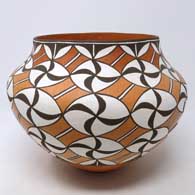Lolita Concho
Acoma

Lolita Torivio Concho was born into Acoma Pueblo in 1914 and passed on in 2000. She was the daughter of Antonio and Teofila Torivio, sister of Frances Torivio, Connie Torivio Garcia, Juanita Torivio and Mamie Torivio-Ortiz. Wanda Aragon, Frances' daughter, recalled growing up in the village of McCartys with her extended family all around. Among the women's favorite and most frequent activities was getting together for company and for mutual aid as they made pottery. Everyone was involved in all the different stages of the process, from gathering the clay to processing it to forming pieces to decorating and firing them. As all the children were involved in and learned from the group's daily tasks, that's how the pottery making tradition was passed on. Lolita, Frances and Mamie were in the heart of that, assisting everyone in every stage of the process.
Lolita's daughter Shirley decided early on she wasn't going to become a potter, so Lolita's red paint, four base bowls and her favorite polishing stone were inherited by her daughter-in-law, Dorothy Torivio. It was Lolita who taught Dorothy techniques for painting the tight even lines that she became famous for. Lolita was a participant in the Santa Fe Indian Market in the 1970s and 1980s. She earned multiple First, Second and Third Place ribbons in those years. She was also featured in the "One Space: Three Visions" exhibit at the Albuquerque Museum in 1979. Her work is shown at the Philbrook Museum of Art in Tulsa, OK, the School for Advanced Research in Santa Fe, NM, and held in many private collections.
She preferred to make traditional Acoma shapes: jars, bowls, vases and canteens. Among her favorite designs were black-on-white tularosa spirals and fine line patterns, and polychrome berry bushes, parrots, flowers and frets. Lolita sometimes signed her pieces: L. Concho. She had a prosperous career, making pottery for collectors and museums. An outstanding potter, she was one of the few at Acoma who could make large jars. She was also one of the driving forces behind the 1970s revival of traditional pottery making at Acoma Pueblo.
(505) 986-1234 - www.andreafisherpottery.com - All Rights Reserved
